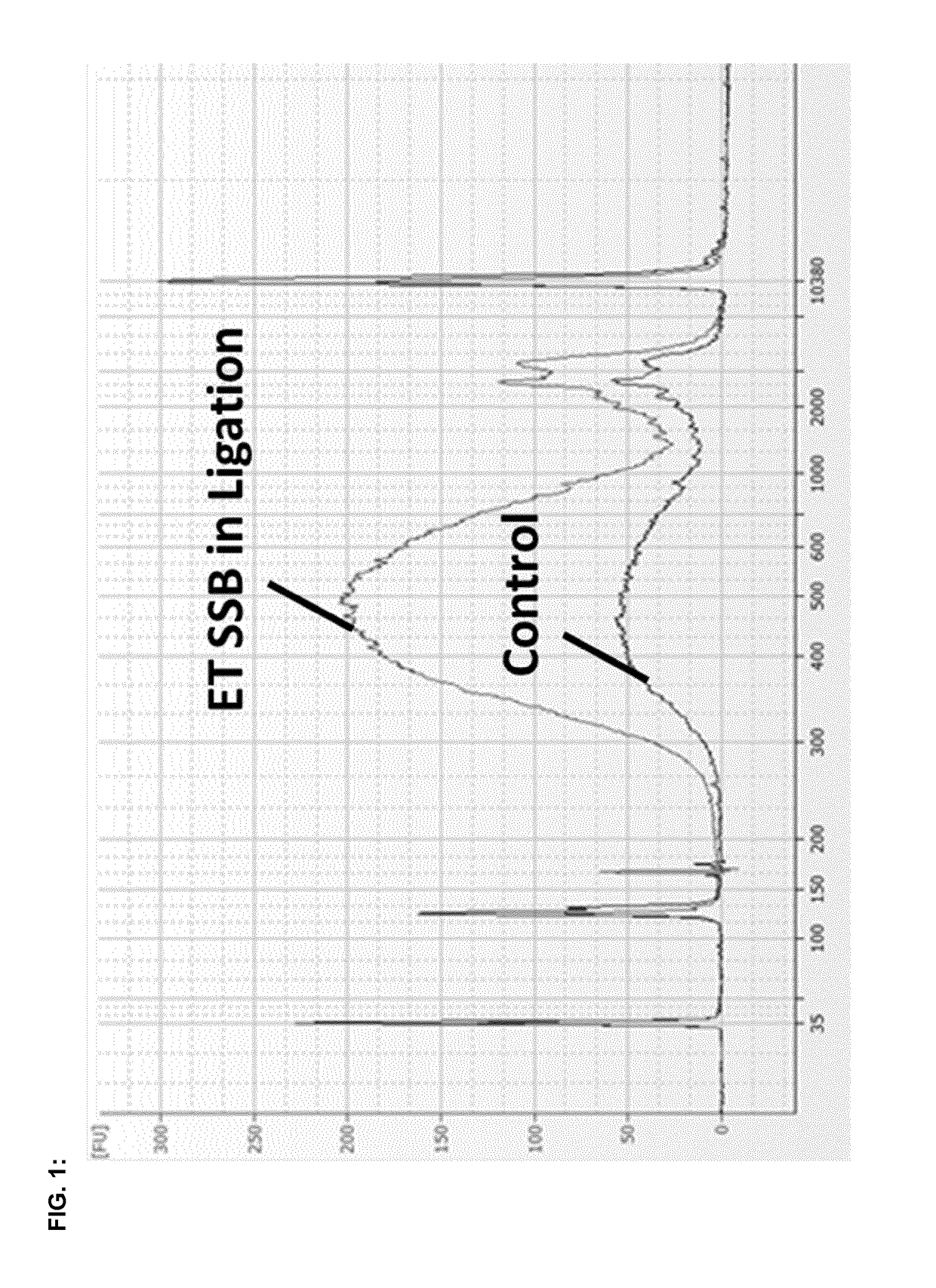Efficiency improving ligation methods
a technology of efficiency improvement and ligation method, which is applied in the field of efficiency improvement of ligation reaction kits, can solve the problems of low efficiency of current library generation methods and the inability to reliably generate sequencing libraries from more than 1 ng starting materials, and achieve high stringency conditions, high hybridization stringency and ligation specificity, and exceptional thermostability
Inactive Publication Date: 2018-05-31
QIAGEN GMBH
View PDF4 Cites 9 Cited by
- Summary
- Abstract
- Description
- Claims
- Application Information
AI Technical Summary
Benefits of technology
This patent is about a method of cloning genes using DNA ligation reactions. The patent is not restricted to the length of the DNA used, but it should agree with the goal of the invention. The ratio of DNA to be ligated should be between 1 part vector to 1-2 parts gene. Vectors can be any compatible with the host cells used for transformation. The preferred enzyme for DNA ligation is T7 DNA ligase, followed by Ampligase® or E. coli DNA-ligase for cohesive end ligation. SSB or dsDNA binding proteins can be used to facilitate the ligation reaction. The invention provides a way to efficiently clone genes and has a wide scope of application.
Problems solved by technology
Currently, most available library construction methods can only reliably generate a sequencing library from more than 1 ng starting materials.
The low efficiency of current library generation methods can be a draw-back if a sequencing library needs to be constructed from samples where only a small amount of input DNA is available, such as biopsy samples, circulating nucleic acids, ancient DNA, and FFPE samples.
Method used
the structure of the environmentally friendly knitted fabric provided by the present invention; figure 2 Flow chart of the yarn wrapping machine for environmentally friendly knitted fabrics and storage devices; image 3 Is the parameter map of the yarn covering machine
View moreImage
Smart Image Click on the blue labels to locate them in the text.
Smart ImageViewing Examples
Examples
Experimental program
Comparison scheme
Effect test
example 1
[0144]The above amplified product of the test and control samples was qualitatively analyzed by using Agilent Bioanalyzer and High Sensitivity DNA Analysis Kit (Agilent).
example 2
[0145]The above amplified product of the test and control samples was quantitatively analyzed by using qPCR method (QuantiFast Sybr Green Kit, QIAGEN).
the structure of the environmentally friendly knitted fabric provided by the present invention; figure 2 Flow chart of the yarn wrapping machine for environmentally friendly knitted fabrics and storage devices; image 3 Is the parameter map of the yarn covering machine
Login to View More PUM
| Property | Measurement | Unit |
|---|---|---|
| temperatures | aaaaa | aaaaa |
| temperatures | aaaaa | aaaaa |
| pH | aaaaa | aaaaa |
Login to View More
Abstract
The present invention provides new methods and kits to improve the efficiency of ligation reactions, in particular in molecular biology applications, such as the next generation sequencing (NGS) library construction methods. In next-generation sequencing methods, the ligation step is critical in adding sequencing platform-specific adapters to the DNA fragments that are to be sequenced. Said improvement is achieved by the addition of single- or double-stranded DNA-binding proteins in the ligation step.
Description
FIELD OF THE INVENTION[0001]The present invention provides new methods and kits to improve the efficiency of ligation reactions, in particular in molecular biology applications, such as the next generation sequencing (NGS) library construction methods and gene cloning. In next-generation sequencing methods, the ligation step is critical in adding sequencing platform-specific adapters to the DNA fragments that are to be sequenced. Said improvement is achieved by the addition of single- or double-stranded DNA-binding proteins in the ligation step.BACKGROUND OF THE INVENTION[0002]Double-stranded nucleic acids containing blunt ends or cohesive (sticky) ends with an overhang of one or more nucleotides can be joined by means of intermolecular or intramolecular ligation reactions. Examples for the methods for ligating at a specific site are DNA ligation reactions of cohesive ends of DNA fragments, which have been cleaved by a restriction enzyme, or blunt-ends of DNA fragments. Such ligatio...
Claims
the structure of the environmentally friendly knitted fabric provided by the present invention; figure 2 Flow chart of the yarn wrapping machine for environmentally friendly knitted fabrics and storage devices; image 3 Is the parameter map of the yarn covering machine
Login to View More Application Information
Patent Timeline
 Login to View More
Login to View More Patent Type & Authority Applications(United States)
IPC IPC(8): C12N15/10C12Q1/6874C12Q1/6855
CPCC12N15/1093C12Q1/6874C12Q1/6855C12Q1/6869C12N15/64C12N15/66C12Q2522/10C12Q2522/101
Inventor HEITZ, KATJAFANG, NAN
Owner QIAGEN GMBH
Features
- R&D
- Intellectual Property
- Life Sciences
- Materials
- Tech Scout
Why Patsnap Eureka
- Unparalleled Data Quality
- Higher Quality Content
- 60% Fewer Hallucinations
Social media
Patsnap Eureka Blog
Learn More Browse by: Latest US Patents, China's latest patents, Technical Efficacy Thesaurus, Application Domain, Technology Topic, Popular Technical Reports.
© 2025 PatSnap. All rights reserved.Legal|Privacy policy|Modern Slavery Act Transparency Statement|Sitemap|About US| Contact US: help@patsnap.com


